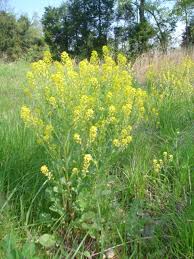Family: Mustard, Brassicaceae.
Habitat: Wasteland, roadsides, grain and other fields crops, primarily in northern Ohio.
Life cycle: Annual annual or summer annual.
Growth Habit: 1-2 feet high, branched and erect.
Leaves: Alternate, 2-7 inches long. Lower leaves have petioles and are irregularly lobed and toothed with bristly hairs; upper leaves are smaller and may not be lobed; petioles lacking or short.
Stem: Branched near top, bristly.
Flower: June – October. 1/2 inch, bright yellow, four-petal flowers borne in small terminal clusters.
Fruit: Slender, slightly curved, smooth seedpod about 1 inch long; borne on upper branches.
Similar plants: The yellow rocket looks similar but has rounded lower leaves that are more heart shaped.
Root: Short taproot.
The problem is….Seeds live in the soil for many years. Very common in cultivated fields. Cultivation brings seeds to the surface where they germinate.
Currently there are 21 weeds on the Ohio Prohibited Noxious Weed List:
- Shattercane (Sorghum bicolor) – February 8
- Russian thistle (Salsola Kali var. tenuifolia) – February 22
- Johnsongrass (Sorghum halepense L. (Pers.)) May 24
- Wild parsnip (Pastinaca sativa) – May 21
- Wild carrot (Queen Anne’s lace) (Daucus carota L.) – June 5
- Oxeye daisy (Chrysanthermum leucanthemum var. pinnatifidum) – May 3
- Wild mustard (Brassica kaber var. pinnatifida) – June 12
- Grapevines: when growing in groups of one hundred or more and not pruned, sprayed,cultivated, or otherwise maintained for two consecutive years. – February 15
- Canada thistle (Cirsium arvense L. (Scop.)) – March 29
- Poison hemlock (Conium maculatum) – May 31
- Cressleaf groundsel (Senecio glabellus)
- Musk thistle (Carduus nutans) – March 26
- Purple loosestrife (Lythrum salicaria) – April 17
- Mile-A-Minute Weed (Polygonum perfoliatum) – March 7
- Giant Hogweed (Heracleum mantegazzianum) – March 14
- Apple of Peru (Nicandra physalodes) – February 28
- Marestail (Conyza canadensis)
- Kochia (Bassia scoparia) – May 1
- Palmer amaranth (Amaranthus palmeri)
- Kudzu (Pueraria montana var. lobata) – April 11
- Japanese Knotweed (Polygonum cuspidatum) – April 2
Each week, for the next 21 weeks, I will post information and pictures on how to identify these invasive and harmful plants.





